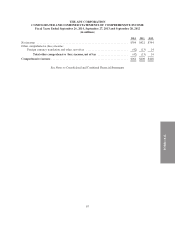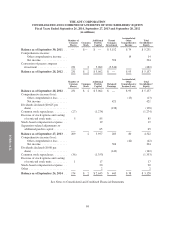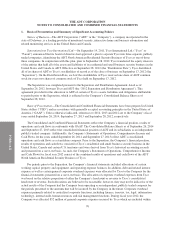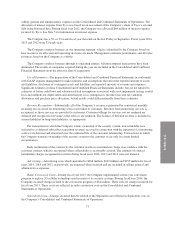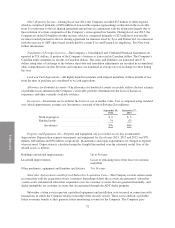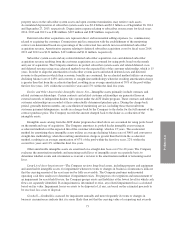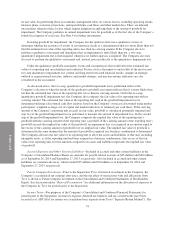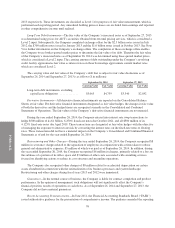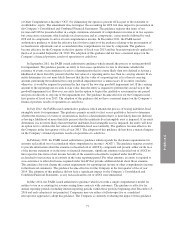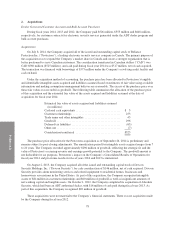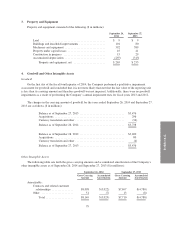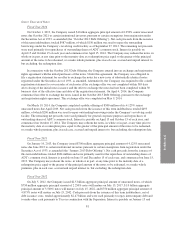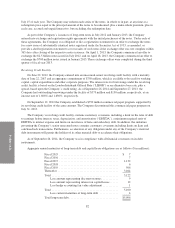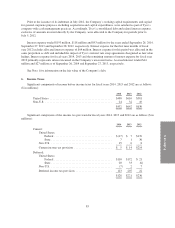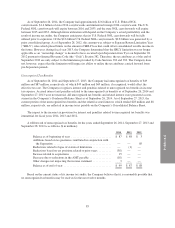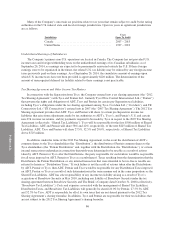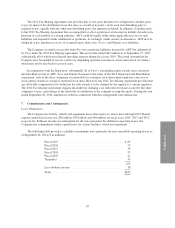ADT 2014 Annual Report Download - page 143
Download and view the complete annual report
Please find page 143 of the 2014 ADT annual report below. You can navigate through the pages in the report by either clicking on the pages listed below, or by using the keyword search tool below to find specific information within the annual report.
FORM 10-K
of Other Comprehensive Income (“OCI”) by eliminating the option to present OCI as part of the statement of
stockholders’ equity. The amendment does not impact the accounting for OCI, but does impact its presentation in
the Company’s Consolidated and Combined Financial Statements. The guidance requires that items of net
income and OCI be presented either in a single continuous statement of comprehensive income or in two separate
but consecutive statements which include total net income and its components, consecutively followed by total
OCI and its components to arrive at total comprehensive income. In December 2011, the FASB issued
authoritative guidance to defer the effective date for those aspects of the guidance relating to the presentation of
reclassification adjustments out of accumulated other comprehensive income by component. The guidance
became effective for the Company in the first quarter of fiscal year 2013 and has been retrospectively applied for
the fiscal year ended September 28, 2012. The adoption of this guidance did not have a material impact on the
Company’s financial position, results of operations or cash flows.
In September 2011, the FASB issued authoritative guidance which amends the process of testing goodwill
for impairment. The guidance permits an entity to first assess qualitative factors to determine whether the
existence of events or circumstances leads to a determination that it is more likely than not (defined as having a
likelihood of more than fifty percent) that the fair value of a reporting unit is less than its carrying amount. If an
entity determines it is not more likely than not that the fair value of a reporting unit is less than its carrying
amount, performing the traditional two-step goodwill impairment test is unnecessary. If an entity concludes
otherwise, it would be required to perform the first step of the two-step goodwill impairment test. If the carrying
amount of the reporting unit exceeds its fair value, then the entity is required to perform the second step of the
goodwill impairment test. However, an entity has the option to bypass the qualitative assessment in any period
and proceed directly to step one of the impairment test. The guidance became effective for the Company in the
first quarter of fiscal year 2013. The adoption of this guidance did not have a material impact on the Company’s
financial position, results of operations or cash flows.
In July 2012, the FASB issued authoritative guidance which amends the process of testing indefinite-lived
intangible assets for impairment. This guidance permits an entity to first assess qualitative factors to determine
whether the existence of events or circumstances leads to a determination that it is more likely than not (defined
as having a likelihood of more than fifty percent) that the indefinite-lived intangible asset is impaired. If an entity
determines it is not more likely than not that the indefinite-lived intangible asset is impaired, the entity will have
an option not to calculate the fair value of an indefinite-lived asset annually. The guidance became effective for
the Company in the first quarter of fiscal year 2013. The adoption of this guidance did not have a material impact
on the Company’s financial position, results of operations or cash flows.
In February 2013, the FASB issued authoritative guidance which expands the disclosure requirements for
amounts reclassified out of accumulated other comprehensive income (“AOCI”). The guidance requires an entity
to provide information about the amounts reclassified out of AOCI by component and present, either on the face
of the income statement or in the notes to financial statements, significant amounts reclassified out of AOCI by
the respective line items of net income but only if the amount reclassified is required under GAAP to be
reclassified to net income in its entirety in the same reporting period. For other amounts, an entity is required to
cross-reference to other disclosures required under GAAP that provide additional detail about those amounts.
This guidance does not change the current requirements for reporting net income or other comprehensive income
in the financial statements. The guidance became effective for the Company in the first quarter of fiscal year
2014. The adoption of this guidance did not have a significant impact on the Company’s Consolidated and
Combined Financial Statements, as any reclassifications out of AOCI were immaterial.
In May 2014, the FASB issued authoritative guidance which sets forth a single comprehensive model for
entities to use in accounting for revenue arising from contracts with customers. The guidance is effective for
annual reporting periods (including interim reporting periods within those periods) beginning after December 15,
2016 and early adoption is not permitted. Companies may use either a full retrospective or a modified
retrospective approach to adopt this guidance. The Company is currently evaluating the impact of this guidance.
77


